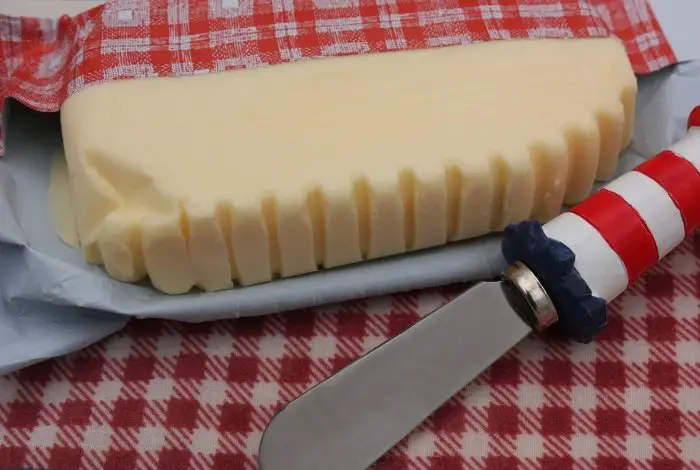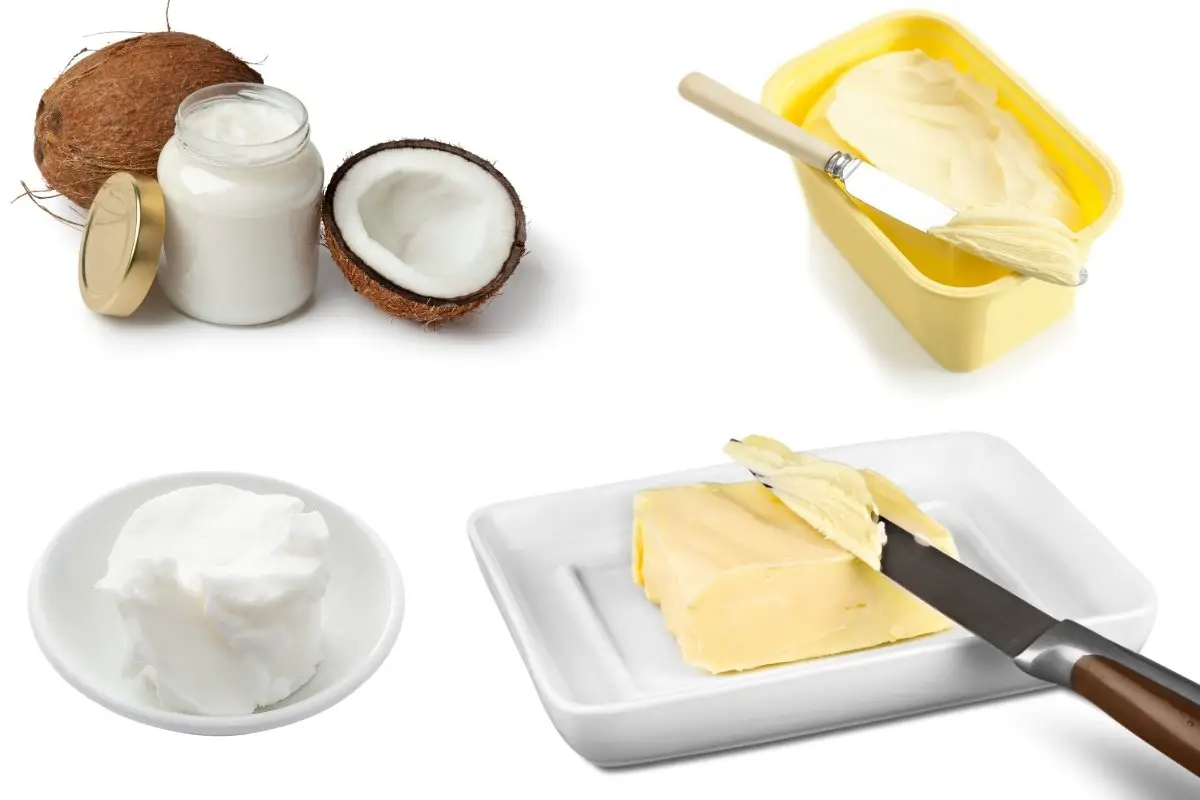Last Updated on January 23, 2022
If you cannot tolerate dairy and find your fridge empty of unsalted butter? I believe it is best to have a substitution for unsalted butter. For a cup of unsalted butter, substitute 3/4 cup or 2tbsp of coconut oil or a vegetable shortening cup. Any substitute for unsalted butter will change the flavor and texture of the baked good. Essentially, unsalted butter is useful in the kitchen, especially for pie crusts, cookies, cakes, cupcakes, and poundcake. If your butter is too warm, do not cream it because your fluffy cake will end up dense, lifeless, and flat. Too cold, and you will wind up with rough chunks of butter in your recipe.
Facts About Unsalted Butter
Salt is a preservative, meaning salted butter has a shelf life longer than unsalted butter. Salted butter has a shelf life of around three to four months. However, it does not mean that it has been longer on the market than unsalted butter; it merely has a longer shelf life. On the other hand, unsalted butter is a fresher product compared to salted butter.
Without the extra savory tones that could throw off your dough or batter’s delicate balance, unsalted butter adds fat and spice. Choose unsalted butter when you are uncertain or in doubt. You can still apply salt in your mixing bowl, but extracting the savory flavor from an over-salted recipe is tougher. Unsalted butter burns less quickly than its saline alternative, as an additional benefit. You can get a neat, healthier, more buttery taste when you use unsalted butter in your baking.
Find out How Much Salt Is In Salted Butter?
Wilton 3-Tier Collapsible Cooling Rack
Substitution For Unsalted Butter
There are different substitutions for unsalted butter. However, margarine, vegetable shortening, coconut oil, and salted butter are the usual substitutions for it since they are easy and effective substitutes. Likewise, they add texture and richness to your baking.
Margarine
It is similar to unsalted butter. However, it has a softer texture than unsalted butter. Melted margarine works best in recipes that require melted butter. Although, in recipes that call for softened butter, substituting margarine can change the texture. For instance, cookies will be less crisp, and it will spread out more. In addition to that, cakes will be less tender.
Vegetable Shortening
Vegetable shortening is most likely preferred as it preserves the consistency of the finished product when baking. So, substitute it with the unsalted butter measure for measure. When substituting it, the cookies’ texture will change depending on whether it is crispy or chewy. Vegetable shortening will change the taste because shortening is not as rich as compared to butter. Instead, vegetable shortening enables the other ingredients to stand out.
Also, a tablespoon of vegetable shortening is not the same as a tablespoon of butter. Unsalted butter is approximately 80 percent fat. Its water is around 15 percent, and the remainder is milk solids. At the same time, vegetable shortening is 100 percent fat.
Coconut Oil
It is a great substitute for unsalted butter. However, it does not spread as much compared to unsalted butter. For instance, if you are making cookies, it does not become as thin as when you use unsalted butter. Coconut oil changes the texture among all other substitutes for unsalted butter. Also, it adds moisture. Use coconut oil at room temperature when substituting unsalted butter. It is essential when making pie crust since coconut oil needs to be solid and chilled when cut into the flour. The same is applied as the butter process.
Salted Butter
This substitution is easy to do. You can use regular salted butter and use less or no salt added to the recipe. To do this, substitute the unsalted butter required in the recipe with an equal quantity of salted butter. Afterward, modify the salt’s quantity in the recipe to account for the extra salt in the butter by lessening the recipe’s salt by 1/4 tsp for every 1/2 cup of butter used.
In the US, a small amount of salt added to the commercial butter sold in a grocery store will not change the recipe in any way. On the other hand, imported butter, farm-sourced fresh butter, and boutique brand butter contain more salt. That is why it should be accounted for when baking.

Conclusion
Use different substitutions for unsalted butter because you want to have absolute control of your baked good’s taste. You can regulate the taste of the finished product since you can control the salt. So, it is ideal for taking a recipe and making it once with each of the substitutions and observe which is the best substitute for unsalted butter.
FAQ’s
Is unsalted butter healthy?
Not only is it considered healthy, but also it is fresher than salted butter. That is why it is the best option for baking. Keep in mind that unsalted butter contains roughly half the salt of regular salted butter.
It would also be best to use unsalted butter to control the recipe’s salt content. Likewise, it can maximize the flavor of baked goods.
Moreover, unsalted butter is abundant in nutrients. It has vitamins A, D, and E that are important for healthy eyes, strong bones, and nourished skin.
Find out How Much Salt Is In Salted Butter?
How do I substitute butter for oil in a cake?
Begin by melting the butter in the microwave. After that, let it cool down to room temperature while assembling the other ingredients. You will know when it is ready to use if it is hardly warm to the touch.
Moreover, substituting the butter for oil, whether vegetable oil or canola oil, results in a moister cake. The main reason is that butter has water and fat. Also, it provides richness to the crumb. In addition to that, cakes made with butter usually taste better compared to oil cakes.
What is the best oil for baking cakes?
Canola oil is the best option for baking because it is a neutral-tasting oil. It will allow the taste of the cake to stand out, from spice and carrot to vanilla and chocolate. All of it works perfectly with canola oil, not to mention that it is a healthier option.
In general, keep in mind that you can use different kinds of oil for baking; however, they all vary in price. Often, several oils can change the flavor of the cake.
What happens if you use salted butter instead of unsalted in baking?
Usually, what will occur is that you will have no clue how much salt you used in the recipe since it differs between every brand you see at the grocery.
For the most part, recipes maintain a little amount of salt in the ingredients. Thus, salted butter has a major disadvantage since you cannot control the salt quantity in the butter. Remember, salted butter usually has one-fourth to three-fourth of salt per half-cup.
In addition to that, omitting the salt needed for the recipe and using salted butter does not end well. Worst case scenario, your baked goods will become too salty.
Find out the answer to this question Do I Use Salted Or Unsalted Butter For Cookies? Help!
Why do some recipes call for unsalted butter?
It is because the salt levels in the recipe account for no other salt source. That is why some recipes call for unsalted butter and not for salted butter.
Moreover, it would be best to use unsalted butter in baked goods where the sweet, creamy taste of butter is essential, like pound cakes or butter cakes.
You can store unsalted butter in the fridge, and it can last for about a month. To check if unsalted butter has gone wrong, you can always tell by the smell, or you can cut the unsalted butter in half. And if the inside color is different from the outside, it is best not to use it anymore.

Zarah is an experienced pastry chef whose creations have delighted countless customers. With a passion for baking, Zarah has developed a unique style that combines classic techniques with modern flavors. Her desserts are consistently crafted with the finest ingredients, and her attention to detail is evident in the stunning and delectable results. Zarah has a wealth of experience in the pastry kitchen, and loves to share her knowledge with others. Whether it is teaching a class or creating a custom cake for a special occasion, Zarah is committed to making sure every customer is satisfied.


